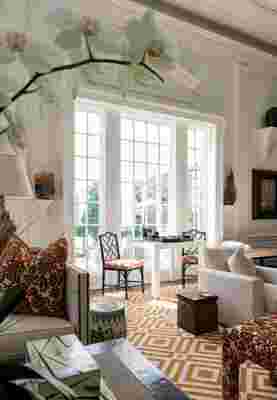Every presidential transition is marked by some anxiety and discord, but the fear, tumult, and divisiveness that have characterized the start of the Trump era would seem to have few analogs in U.S. history. Such is the depth of feeling that it would be surprising if the shifting tenor of the times were not reflected in the country’s architecture and design. And changes, designers and developers say, are on the horizon. The stark, modernist interiors that have dominated the last few years are falling out of favor. But don’t expect a return to the opulent, overstuffed interiors of the 1980s apparently fancied by Trump , either. The predominant trends of the coming year will favor authenticity and softer, elegant lines, as well as antiques and eclecticism.
They will, in other words, be conciliatory rather than reactionary. Our political system may be unable to find middle ground, but American homes, at least, can embody it.
“In the last three years there was an extremely strong trend toward streamlined and modern, but recently, blogs, Instagram, and my younger clients have all been talking about antiques,” says designer Marshall Watson of Marshall Watson Interiors . “People are striving for something that’s both pretty and elegant. Curves are coming back into furniture, arms are coming back into furniture. We’re seeing the use and revival of mahogany-inlaid 18th-century antiques, French antiques, deep comfortable sofas, open-shelved kitchens, black paint, brass.”
The use of brass and gold, he added, predates Trump’s presidency. “It’s a free-for-all mixture of old and new pieces—a little more rumpled, less designed, much more human feeling,” Watson says.
Maxime Vandal and Richard Ouelette of Montreal- and New York–based design firm Les Ensembliers agree that “comfort” and “things that speak to you” have upended the primacy of clean lines and coordinated looks. While they had turned away from “matchy-matchy”—in everything from era-specific furniture to austere color schemes—before the election, Vandal speculates that the swift onset of the new political order has hastened the transition.
“The idea is disruption—it doesn’t have to be a perfect room anymore. People want things that have meaning,” Vandal says.

A Palm Beach interior designed by Les Ensembliers.
“I think we’ll be mixing a lot of patterns, fabrics with different colors and textures. It’s not about one style or one era anymore,” says Ouelette. “The old brown grandmother’s pieces will come back, mixed with things that are more contemporary and streamlined.” The living room of a Palm Beach, Florida, home they recently decorated, for example, blended Regency-style furniture, wall panels from the 1930s, and a chinoiserie chair upholstered in contemporary fabric from Kelly Wearstler.
Soundbites are out, as is slickness. Stories—and florals—are in.
“We all feel a bit disturbed, and I think we need to connect to something,” continues Ouelette. “The movement right now is about maximalism—we want to be connected to our homes; we want to build stories.”
The trend, agrees John Meeks of design firm Aman & Meeks , “is toward renewed eclecticism that juxtaposes well-designed rooms with top-quality period pieces and antiques.”
His partner, James Aman, describes the shift as "more transitional than traditional.”
“It’s not that midcentury modern has necessarily fallen out of favor, but as demand goes up and prices go up, it forces people to move on,” Aman says.
Authenticity and more permeable borders are also appearing in architecture, according to AJ Pires, partner and cofounder of Alloy Development, which has two waterfront projects—One John Street, in Brooklyn Bridge Park, and 8050 in Vero Beach, Florida.
“Our buildings sit on berms—it’s not like being on a concrete table, this walled-off, bunker-like approach,” says Pires. “It’s a more honest approach—it makes you aware of where you are in relation to the water.”
“People are responding to much more honest, authentic design,” he explains. “Part of the nature of the political climate we live in is that people are looking for design solutions that are honest about the facts.” Changing environmental concerns also play a role in his and his prospective buyers' top design considerations. "We've been thinking a lot how to design for resiliency," Pires says. "Thinking about the building as an integral part of the landscape. I think people are starting to understand that."
The political overtones may be muted—for now—but they’re certainly present. While noting that he wasn’t among them, Watson admits that many of his design peers were “appalled” by photos of Trump’s penthouse: “All the Aubusson rugs, really heavy furniture, overpacked with crystal, mirrors everywhere, heavily gilded gold frames. There’s a lot of flash that designers are reacting against.”
In this, Watson notes, the Trump White House may be unique—in the past, presidential taste was either imitated or ignored.
“Reagan style—that kind of Republican chic that came out of California—did affect people. And there’s no question that Jackie Kennedy did. As for the Clintons, that was not a stylish White House, and I don’t think anyone copied the Bushes,” Watson says. “People didn’t particularly know what the Obama White House looked like, but it was very tasteful, measured, thoughtful design. Some beautiful antiques, nothing radical.”